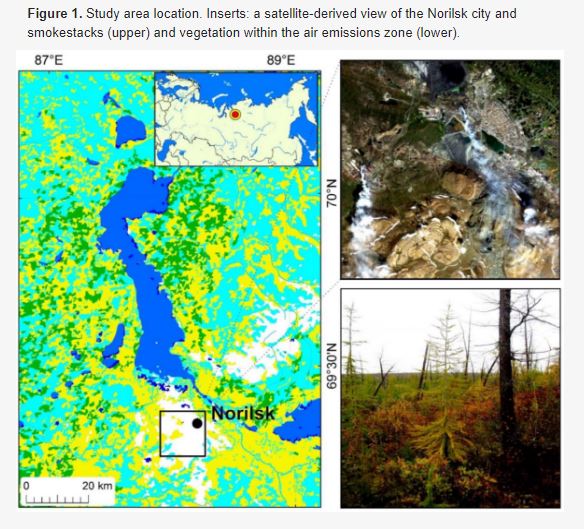March 15, 2023
Russian scientists have assessed how the vegetation of Arctic wetlands behaves under the influence of industrial emissions from Norilsk city and climate change. Before the nineteen nineties, trees and shrubs were oppressed and died due to high sulphur emissions. However, starting from the two thousandth, after reduction of pollution and increase of summer and autumn air temperatures, they began to recover. The results of the study are published in the Water journal.
The Siberian Arctic is located in the "hot spot" of the warming, it heats up much faster than the rest of the planet. Along with this, forests and swamps that are located in the impact zone of the Norilsk copper-nickel ore extraction and processing industry are heavily impacted by man-caused pollution. Moreover, in 2020, there was an incident with some release of petroleum products in this area.
Scientists from the Federal Research Centre "Krasnoyarsk Scientific Centre of SD of RAS" (FRC KSC of SD of RAS) and the Siberian Federal University (SFU) assessed the combined impact of climate warming, long-term pollution by sulphur dioxide emissions and the recent spill of diesel fuel on trees and shrubs in the permafrost zone near Norilsk.
 The researchers came to a conclusion that along with the chronic effects of sulphur dioxide emissions, the growth of Siberian larch in the studied territories is limited by air and soil temperatures, also by excessive waterlogging. A decrease in the radial growth of larch trees, their damage and death have been observed since the 1950s and reached peaks in the 1990s. The high spring temperature negatively affects the activeness and tolerance of trees. Experts note that early spring heat leads to some decrease in growth by activating metabolism in the absence of soil moisture. The "awakened" tree begins to grow, while the roots located in the still frozen soil cannot provide it with life-giving moisture. This results in drying of young shoots and their damage.
The researchers came to a conclusion that along with the chronic effects of sulphur dioxide emissions, the growth of Siberian larch in the studied territories is limited by air and soil temperatures, also by excessive waterlogging. A decrease in the radial growth of larch trees, their damage and death have been observed since the 1950s and reached peaks in the 1990s. The high spring temperature negatively affects the activeness and tolerance of trees. Experts note that early spring heat leads to some decrease in growth by activating metabolism in the absence of soil moisture. The "awakened" tree begins to grow, while the roots located in the still frozen soil cannot provide it with life-giving moisture. This results in drying of young shoots and their damage.
However, starting from the two thousandth years, vegetation in this area of the Arctic began to recover. In particular, the researchers noted an increase in the growth of larch trees, as well as an increasing productivity of vegetation cover. This was positively impacted by the reduction of sulphur dioxide emissions, climate warming, elongation of the vegetation period and migration of sulphur dioxide resistant plants to the damaged areas. It is assumed that industrial emissions of nitrogen oxides could also contribute to an increase in productivity, transforming into nitrogen fertilizers. This being said, the scholars assessed the impact of the 2020 fuel spillage on vegetation as insignificant.
"Emissions from the Norilsk industry used to cause the largest loss of vegetation over the Arctic Circle. In addition, these territories are experiencing very heavy impact of climate warming. We studied the influence of a combination of these factors on the flora of the Arctic zone. A strong negative side effect of the Norilsk industry is air pollution with sulphur dioxide, dust and heavy metals. This significantly worsened the ecological situation and had a negative effect on the vegetation cover. However, we assume that current climate changes may mitigate the adverse effects of pollution on the growth of trees and shrubs. In addition, some types of ligneous plants, in particular willows and birches, proved to be more resistant to man-caused pollution. We assume that they will play an important role in the restoration of vegetation cover in the damaged areas in the vicinity of Norilsk," - said Ilya Petrov, Candidate of Biological Sciences, senior researcher at the Institute of Forest named after V.N. Sukachev, FRC KSC of SD of RAS.
Sources:
https://www.mdpi.com/2073-4441/15/2/215
Translated by Muhiddin Ganiev